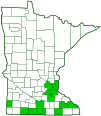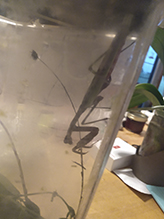Chinese mantis
(Tenodera sinensis sinensis)
Conservation • Description • Habitat • Ecology • Distribution • Taxonomy
|
|
||||||||||||||
Description |
Chinese mantis is a large, exotic, predaceous insect. It is native to Japan, China, North and South Korea, Thailand, and Micronesia. It was accidentally introduced in Philadelphia in 1896. It is now common in the United States and southern Canada east of the Great Plains, in California west of the Rocky Mountains, and in most of Asia. It is uncommon in the southern third of Minnesota, where it is at the northwestern extent of its range, and is absent from the remainder of the state. It is found in grasslands, meadows, agricultural fields, and woodlands, and at the sides of streams and rivers. Adults are active in summer until fall, when they are killed by the first frost. They eat anything they can catch, including insects, small amphibians and reptiles, and hummingbirds. Chinese mantis is the largest mantid in the United States. Mature adults can be 2″ to 5″ (51 to 127 mm) in length but they average just 2¾″ (70 mm) long. They may be green, tan, or both in parts. The head is triangular. There are two very large compound eyes and three small simple eyes (ocelli). The compound eyes are on the front of the head, are bulging, and are directed forward. In low light they appear black but in daylight they are the same color as the head. The ocelli are between and above the antennae bases. There is no raised projection (tubercle) between the eyes. The antennae are short, thin, and thread-like. The three facial shields covering the front of the face are distinctly vertically striped. The upper plate, the one between and below the antennal bases, is squarish, about as long as wide. The structures between the head and thorax are very flexible. The head can be swiveled 180°, allowing the mantis to look “over its shoulder.” The first section of the thorax (prothorax) is greatly elongated. It is much longer than the first segment (coxa) of the front legs. It is widest behind the head then greatly narrowed ahead of the point where the front legs are attached. The forewings (tegmen) are mostly thin, pliable, and somewhat transparent (membranous). They may be green or tan. The leading edge (costal area) is green on both green and tan tegmen. The hindwings are heavily marbled and are much broadened from front to rear. The front legs are adapted for seizing prey (raptorial). On the underside of the thorax, between the coxae, there is a large yellow spot. On each front leg the coxae are greatly lengthened. The third and fourth segments (femur and tibia respectively) are armed with spines. The tibia is more than half as long as the femur. It has several teeth on the underside and no teeth on the upper side. The last part of the leg (tarsus), corresponding to the foot, has five segments. The middle and hind legs are long and slender. On the rear legs the upper surface of the tibia is rounded. |
Size |
Total length: 2″ to 5″ (51 to 127 mm) |
Similar Species |
Habitat |
Grasslands, meadows, agricultural fields, and woodlands, and at the sides of streams and rivers |
Ecology |
Season |
Summer and fall |
Behavior |
Adults are active during the day. They remain stationary with their legs raised up as they wait for prey. Though they have wings, females do not fly. Males can fly only short distances. |
Life Cycle |
Adults mate in September. About half of the males are snatched and eaten by the female after mating. The female produces a single, paper mache-like case (ootheca) with 50 to several hundred eggs. The ootheca is usually attached to a bush, small tree, or other vegetation. The eggs overwinter and hatch late in the following spring. Hatchlings are dispersed by the wind. Most nymphs die of starvation or desiccation. Those that survive moult seven times before becoming an adult. |
Nymph Food |
|
Adult Food |
Insects and small animals, including amphibians, reptiles, and hummingbirds. |
Distribution |
||
|
Sources |
|
| 9/15/2024 | ||
Occurrence |
||
Uncommon in Minnesota |
||
Taxonomy |
|
Order |
Mantodea (mantises) |
Suborder |
Eumantodea (extant mantises) |
Infraorder |
Schizomantodea |
Superfamily |
Mantoidea |
Family |
Mantidae (mantids) |
Subfamily |
Tenoderinae |
Tribe |
Tenoderini |
Subtribe |
Tenoderina |
Genus |
Tenodera |
Species |
Tenodera sinensis |
Until recently, Chinese mantis was classified as Tenodera aridifolia sinensis, a subspecies of giant Japanese mantis, which sometimes goes by the same common name. In 2002 it was raised to species level based on differences in the male genitalia. |
|
Subordinate Taxa |
|
|
|
Synonyms |
|
Tenodera aridifolia Tenodera aridifolia sinensis |
|
Common Names |
|
Chinese mantid Chinese mantis giant Japanese mantis (erroneously) |
|
Glossary
Femur
On insects and arachnids, the third, largest, most robust segment of the leg, coming immediately before the tibia. On humans, the thigh bone.
Ocellus
Simple eye; an eye with a single lens. Plural: ocelli.
Tarsus
On insects, the last two to five subdivisions of the leg, attached to the tibia; the foot. On spiders, the last segment of the leg. Plural: tarsi.
Tegmen
The modified, leathery front wing of grasshoppers and related insects that protects the hindwing. It may also serve as a camouflage, a defensive display, or a sound board. Plural: tegmina.
Tibia
The fourth segment of an insect leg, after the femur and before the tarsus (foot). The fifth segment of a spider leg or palp. Plural: tibiae.
Tubercle
On plants and animals: a small, rounded, raised projection on the surface. On insects and spiders: a low, small, usually rounded, knob-like projection. On slugs: raised areas of skin between grooves covering the body.
Visitor Photos |
||
Share your photo of this insect. |
||
This button not working for you? |
||
Shawn Winn |
||
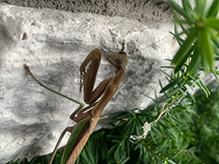 |
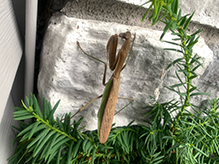 |
|
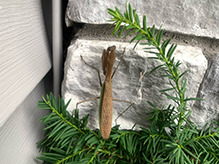 |
||
Alfredo Colon |
||
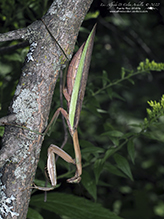 |
||
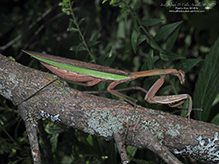 |
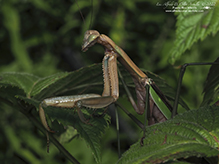 |
|
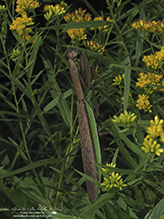 |
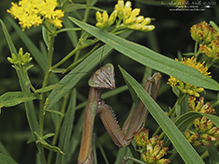 |
|
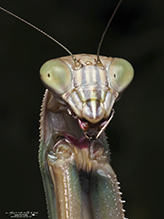 |
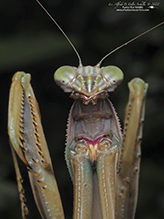 |
|
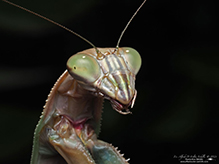 |
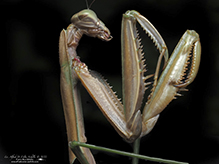 |
|
Greg L. |
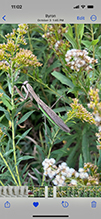 |
J. Hughes |
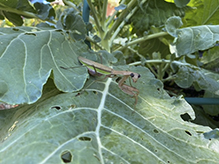 |
Big Black eyes = thirsty |
Ryan H. |
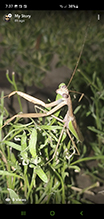 |
Babette Kis |
||
Chinese mantid Tenodera sinensis sinensis Chinese mantid three and five eighths inches long 8 29 2020. This large Chinese mantid was photographed at Chiwaukee Prairie, Kenosha Co., Wisconsin. … There were a number of butterfly wings on the ground under the shrub this mantid was on. |
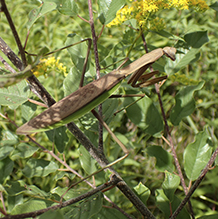 |
|
Rollie |
||
I was watering my flower pots and when it first splashed, I noticed one hop up out of my begonias and sit on top. He was 4+” long and very pretty. He didn’t mind us looking closely at him and taking photos. I love how he turned slowly and looked right at me! It was fun to see!! |
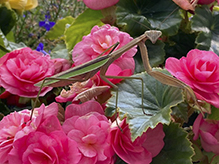 |
|
David Sorenson |
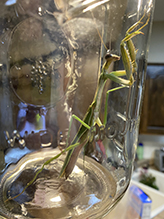 |
found it on our garage door |
Nate Redig |
||
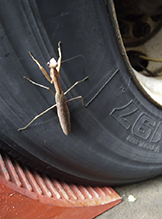 |
||
My Science teacher said I should report the praying mantis, it is about 4 and 1 fourth inches long (not including the hand spike things) also here is a photo |
||
Corey Anderson |
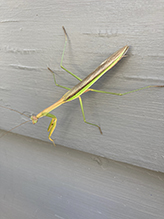 |
Found today on the side of my mother’s house in Jackson….. is rather large 3+ inches. |
MinnesotaSeasons.com Photos |
||
|
||
|
||

Slideshows |
|

Visitor Videos |
||
Share your video of this insect. |
||
This button not working for you? |
||
David Sorenson |
Chinese Mantis 01 |
About
Chinese mantis (Tenodera sinensis sinensis) |
Other Videos |
||
Tenodera sinensis Short Educational Piece. |
About
Dec 9, 2019 A short educational piece on the Chinese mantis for people who are curious. |
Praying Mantis Handling (Tenodera sinensis) |
About
Aug 26, 2019 This was filmed at 5 Rivers Environmental Education Center in New York. There were a bunch of these here, which makes me wonder if that explains why I haven't found any Black and Yellow Garden Spiders here. This is a Tenodera sinensis. |
Chinese Praying Mantis (Tenodera Sinensis) in action catching an insect |
About
Jan 29, 2015 A clip of Chinese praying mantis (Chinese Mantid) catching insects off the flower. |
Chinese mantis (Tenodera sinensis) |
About
Mar 13, 2021 #Dlium Chinese mantis (Tenodera sinensis) is an animal species in the Mantidae, winged and arboreal insects, active predators and cannibals, has a long and slender shape with varying colors, lives solitary in bushes and low trees in forests, agricultural land, abandoned lands and urban. T. sinensis has a length of up to 11 cm, slender, color varies from overall green to brown, dorsal margins are white with green side stripes on the forewings in the form of brown. The head is triangular in shape with linear lines between the eyes. A pair of eyes have a large size and dominate the head, black or green or gray. Between the forelegs are yellow or brown. The legs are long and have several joints. The forelegs are large and flattened with rows of spikes. Females can produce several semi-spherical oothecae, 2 cm in diameter and contain up to 400 eggs. Oothecae are often attached to plants such as shrubs and small trees. The Chinese mantis feeds on bees, spiders, grasshoppers, cicadas, small reptiles, amphibians to hummingbirds. |
Chinese mantis (Tenodera aridifolia sinensis) |
About
Dec 11, 2020 Filmed 18 Sep 20 |

Visitor Sightings |
||
Report a sighting of this insect. |
||
This button not working for you? |
||
small beans sksksk |
Location: Postville, Iowa found one dead and one alive Postville Iowa |
|
Shawn Winn |
Location: 1102 Tikalsky Street SE, New Prague, MN 56071 |
| Greg L. 10/3/2023 |
Location: Rural Olmsted County |
| J. Hughes 9/14/2023 |
Location: Lake County Illinois Big Black eyes = thirsty |
| Ryan H. 9/12/2023 |
Location: Northfield, MN |
| Crystal 9/3/2023 |
Location: Brainerd MN at North central speedway Was a bit confused when I noticed it and none (us) of have seen one before, after looking it up we learned they are in Minnesota. |
|
| Greg 10/4/2022 |
Location: Rochester, MN area On tall weeds. |
|
SRM |
Location: Lanesboro MN, Fillmore County |
|
| Rollie 9/5/2022 |
Location: Rosemount, MN I was watering my flower pots and when it first splashed, I noticed one hop up out of my begonias and sit on top. He was 4+” long and very pretty. He didn’t mind us looking closely at him and taking photos. I love how he turned slowly and looked right at me! It was fun to see!! |
| Alfredo Colon 8/29/2022 |
Location: Albany, NY |
| David Sorenson 10/5/2021 |
Location: St. Paul near state fair fairgrounds found it on our garage door |
| Bobbie Lien 9/25/2021 |
Location: Moorhead, MN Saw a Chinese praying mantis on our deck here in Moorhead this date. Never seen one here before and understand we should not see one this far north in MN. Climate change? |
|
| Corey Anderson 9/1/2021 |
Location: Jackson, MN Found today on the side of my mother’s house in Jackson….. is rather large 3+ inches. |
| Nate Redig 8/27/2021 |
Location: in the area in the middle between Winona and (small area) Wilson and the interstate going past Wilson. My Science teacher said I should report the praying mantis, it is about 4 and 1 fourth inches long (not including the hand spike things) also here is a photo |
| Babette Kis 8/29/2020 |
Location: Chiwaukee Prairie, Kenosha Co., Wisconsin Tenodera sinensis sinensis Chinese mantid three and five eighths inches long 8 29 2020. This large Chinese mantid was photographed at Chiwaukee Prairie, Kenosha Co., Wisconsin. … There were a number of butterfly wings on the ground under the shrub this mantid was on. |
MinnesotaSeasons.com Sightings |
||
|

Created: 9/6/2021 Last Updated: © MinnesotaSeasons.com. All rights reserved. |
